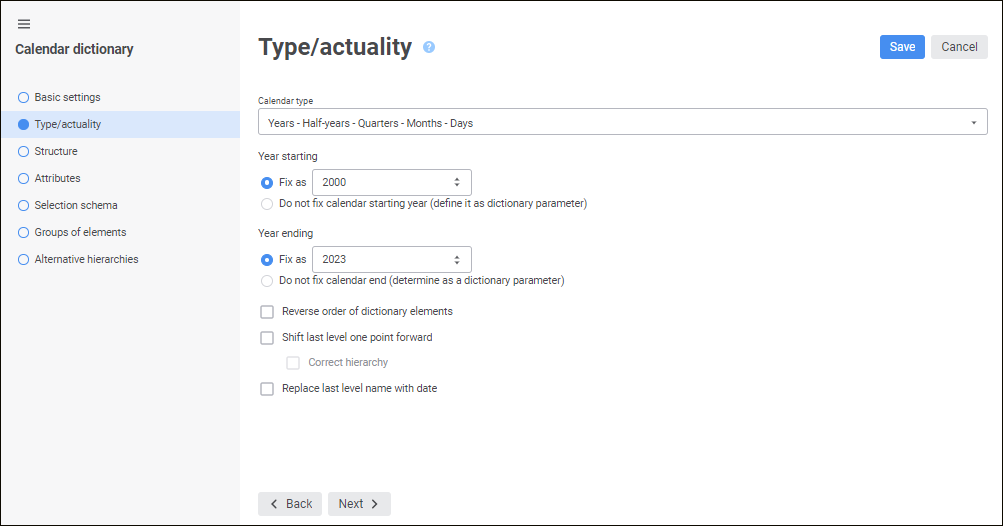 Create a calendar dictionary
Create a calendar dictionaryA calendar dictionary contains hierarchical view of time scale with defined drillthrough. The drillthrough is available by the following levels: years, nine months, half-years, quarters, months, weeks and days. Dictionary contents is generated automatically depending on the specified parameters.
A calendar dictionary allows for dynamic setting of beginning and end of the time scale, that is, this is a dynamic dictionary.
Building this type of dictionary does not require creating tables and linking table elements. The user only needs to select calendar levels, whereas elements and their interaction are generated by the system.


The wizard contains the pages:
Basic Settings/Basic Properties. The page is used to set object name, identifier and comment.
Type/Actuality. The page is used to set basic parameters, which determine calendar hierarchy and start year and end year of calendar period.
Structure. The page is used to specify levels that are available in calendar hierarchy.
Attributes. The page is used to create a set of advanced custom attributes that describe each dictionary element.
Selection Schemas. Selection schemas are set for automatic selection of dictionary elements by specified rules. Going to the page is available after saving dictionary settings.
Groups of Elements. Groups of elements are determined to limit the number of available dictionary elements. Going to the page is available after saving dictionary settings.
NOTE. The Selection Schemas, Groups of Elements, and Alternative Hierarchies pages are available only in the web application.
To save settings in the dictionary wizard:
In the web application:
Click the Save button.
Select the Save and Close item in the drop-down menu of the Save button. After this the specified settings are saved, the wizard closes, and the object navigator opens.
NOTE. The Save and Close item is available only on editing the settings.
In the desktop application click the Finish button.
Calendar dictionary structure consists of a fixed set of blocks and indexes that will be used to bind source data to calendar elements. Each index is built on dictionary system attributes. Sets of blocks indexes change depending on which calendar type is selected or which levels are included in calendar structure.
Blocks are used to select only elements of specific levels. Each block has a primary unique index built on the Period Start Date (START_DATE) attribute. Depending on the selected block, the dates stored in the data source will be considered as start of years, months and other periods. The dictionary also has indexes that take into account all calendar elements. Below is the list and contents of these indexes:
| Name (identifier) | Attributes included in index | Advanced |
| Primary key (INDEX_MAIN) | Calendar block type (BLOCK_TYPE) Period start date (START_DATE) |
Primary, unique. Always exists in dictionary structure. |
| Calendar element name (INDEX_NAME) | Calendar element name (NAME) | Always exists in dictionary structure. |
| Elements order (INDEX_ORDER) | Order (ORDER) | Unique. Always exists in dictionary structure. |
| Year number index (INDEX_ATTR_YEAR) | Year number (YEAR) | - |
| Half-year number index (INDEX_ATTR_HALF_OF_YEAR) | Half-year number (HALF_OF_YEAR) | - |
| Quarter number index (INDEX_ATTR_QUARTER) | Quarter number (QUARTER) | - |
| Month number index (INDEX_ATTR_MONTH) | Month number (MONTH) | - |
| Week number in year index (INDEX_ATTR_WEEK_OF_YEAR) | Week number in year (WEEK_OF_YEAR) | - |
| Day number in week index (INDEX_ATTR_DAY_OF_WEEK) | Day number in week (DAY_OF_WEEK) | - |
| Day number in month index (INDEX_ATTR_DAY_OF_MONTH) | Day number in month (DAY_OF_MONTH) | - |
| Day number in year index (INDEX_ATTR_DAY_OF_YEAR) | Day number in year (DAY_OF_YEAR) | - |
When setting up dimension bindings use the index that corresponds with calendar data stored in the data source.
See also:
Creating Dictionaries | Table Dictionary | Calculated Dictionary